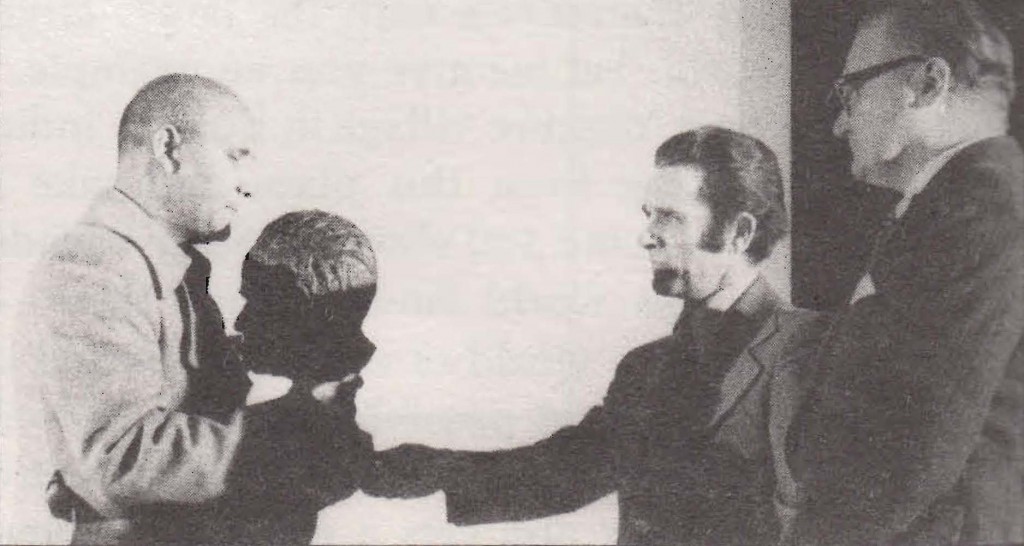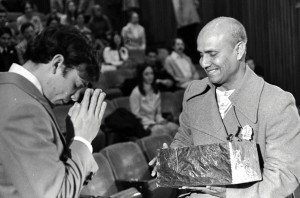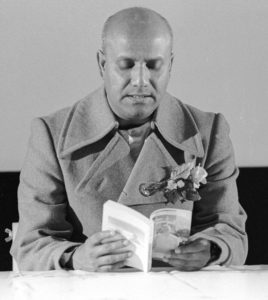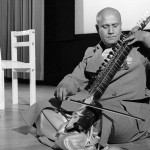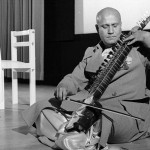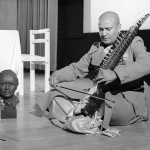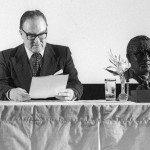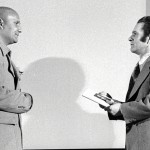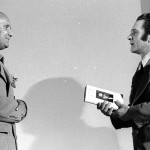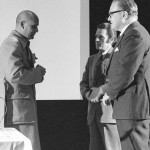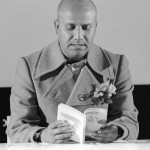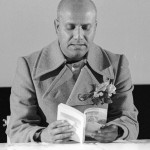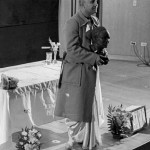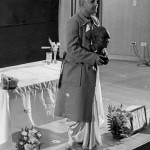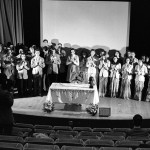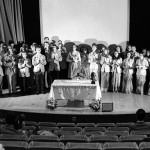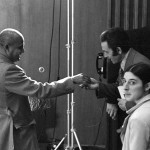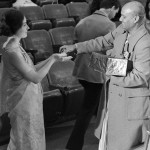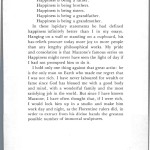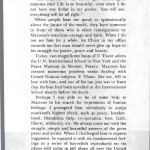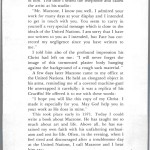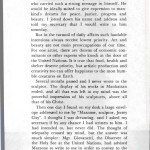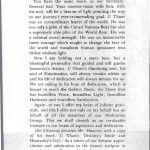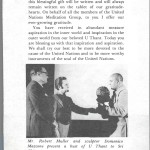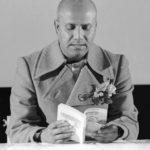Presentation of Mazzone’s Sculpture of U Thant 1977 Feb 18
Filed under Art Exhibits | Other Awards, Citations, Presentations | Tributes and Expressions of appreciationOn 18 February 1977 Dr. Robert Muller presented Sri Chinmoy with a bust of U Thant by sculptor Domenico Mazzone. Dr. Muller had commissioned Mr. Mazzone to do this special sculpture in honour of Sri Chinmoy’s recent programme in tribute to U Thant and the publication of his book, U Thant: Divinity’s Smile and Humanity’s Cry. Sculptor Mazzone was also present at the ceremony.
Dr. Robert Muller and the sculptor Domenico Mazzone present a bust of U Thant to Sri Chinmoy
above is excerpt from: 1977 Devoted Report to the Secretary General
More on PRESENTATION OF MAZZONE SCULPTURE
On 18 February 1977 Mr. Robert Muller, Director and Deputy to the Under-Secretary- General for Inter-Agency Affairs and Co-ordination, presented Sri Chinmoy with a bronze bust of U Thant by sculptor Domenico Mazzone. In honour of Sri Chinmoy’s recent programmes of tribute to U Thant and the publication of his book U Thant: Divinity’s Smile and Humanity’s Cry, Mr. Muller commissioned Mr. Mazzone to do this replica of the sculpture of U Thant which stands in the bronze collection of the United Nations International School of New York.
Sculptor Mazzone was also present as Mr. Muller dedicated the work to Sri Chinmoy with the following words:
Mr. Robert Muller: Dear Sri Chinmoy, as a small token of my deep appreciation for all you have done for the memory of our beloved U Thant, I have commissioned sculptor Domenico Mazzone, another great friend of U Thant, to make for you a bust of the late Secretary-General. It is my pIeasure to offer it to you in memory of him.
Sri· Chinmoy:
Dear Mr. Muller, esteemed brother, I am accepting this with my heart’s infinite gratitude. My heart will always treasure this soulful and blessingful gift of yours. This contains the living presence of our beloved U Thant.
Each member of the Meditation Group at the U.N. will treasure this living presence which I have just received from you both. The memory of this blessingful gift will be written and will always remain written on the tablet of our gratitude hearts. On behalf of all the members of the Meditation Group, to you I offer our ever-growing gratitude.
You have received in abundant measure aspiration in the inner world and inspiration in the outer world from our beloved U Thant. Today you are blessing us with that inspiration and aspiration. We shall try our best to be more devoted to the cause of the United Nations and to be more worthy instruments of the soul of the United Nations.
Mr. Robert Muller and sculptor Domenieo Mazzone present a bust of U Thant to Sri· Chinmoy.
You have the same vision as our Secretary-General had.  Your oneness-vision with him, with his soul, will be a beacon of light pointing the way to our journey’s ever-transcending goal. U Thant was an extraordinary leader of the world. He was not only a pilot of the United Nations-Boat but also a supremely able pilot of the World-Boat. His was a colossal moral strength. His was an indomitable inner courage which sought to change the face of the world and transform human ignorance into divine wisdom-light.
Your oneness-vision with him, with his soul, will be a beacon of light pointing the way to our journey’s ever-transcending goal. U Thant was an extraordinary leader of the world. He was not only a pilot of the United Nations-Boat but also a supremely able pilot of the World-Boat. His was a colossal moral strength. His was an indomitable inner courage which sought to change the face of the world and transform human ignorance into divine wisdom-light.
Now 1 am holding not a mere bust, but a blessingful personality that guided and still guides humanity’s destiny. U Thant’s illumining soul, his soul of illumination, will always remain within us and his life of dedication will always remain for us. We are sailing in his boat of dedication, which is bound to reach the Golden Shore, the Shore that has boundless Peace , boundless Light , boundless Harmony and boundless Satisfaction.
Again, to you I offer my heart of infinite gratitude, and this I offer not only on my behalf but on behalf of all the members of our Meditation Group. This we shall cherish as an invaluable treasure in our heart of aspiration and dedication.
(Sri Chinmoy presents Mr. Mazzone with a copy of his book, U Thant: Divinity’s Smile and Humanity’s Cry) :
As a token of our deepest appreciation and admiration to the master sculptor in you, I wish to offer you this book.
Sculptor Mazzone :
Thank you, thank you very much, I am deeply touched by your words. I feel like crying inside, so beautiful is this ceremony. What you said of U Thant is so true : he is the real light of the world. I have met many celebrities, but U Thant is really unique, so unique that I cannot find the right words. All I can say is that in my view he was very, very close to God. Thank you very much, thank you from the bottom of my heart.
Sri Chinmoy : I wish to play a very short piece on the esraj that I have dedicated to U Thant. It says:
U Thant, U Thant,
We love your silence-soul,
We loved your compassion-heart.
Your world harmony role
Challenged ignorance-dart.
U.N. pilot supreme,
You treasured perfection-dream.
I wish to offer this to the master sculptor in you.
After playing the esraj, Sri Chinmoy asked Mr. Muller to read out a short story Mr. Muller had written about his first acquaintance with Domenico Mazzone and the sculptor’s work for the United Nations.
Mr. Robert Muller:
Dear friends, this comes as a surprise to me, for I did not expect to be called upon to read this little story. I had sent it to Sri Chinmoy in order to acquaint him with the friendship which had developed between U Thant, Mazzone and myself. There are in this world mysterious forces which make it that certain people are destined to meet and to know, love and help each other in the pursuit of a common cause.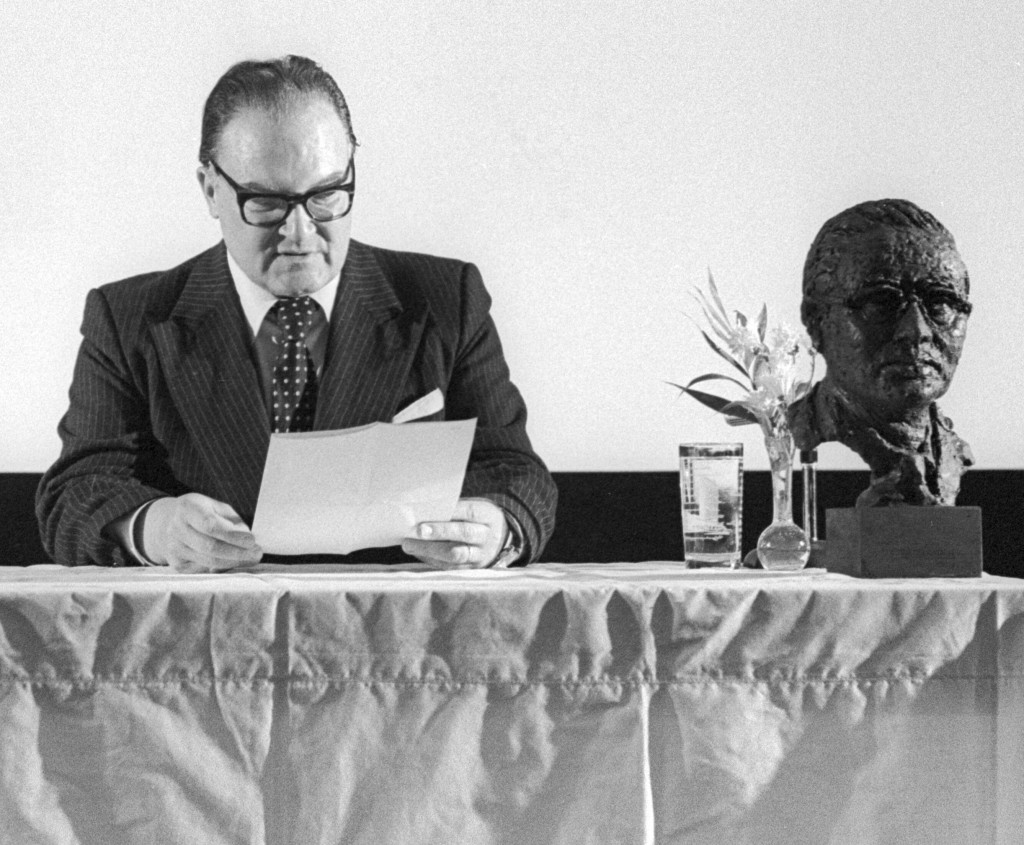 Perhaps a noble objective tends to gather its servants. Or perhaps it happens outside of any rational law. It just happens. The story of my acquaintance with Domenico Mazzone and his presence here today are just two more links in a chain of events. When 1 have a little time, I write down these stories so that they may not be completely lost and may perhaps engender further beautiful happenings in the ascent of mankind. Here is my story of “Mazzone, or the Faith of a Great Artist“.
Perhaps a noble objective tends to gather its servants. Or perhaps it happens outside of any rational law. It just happens. The story of my acquaintance with Domenico Mazzone and his presence here today are just two more links in a chain of events. When 1 have a little time, I write down these stories so that they may not be completely lost and may perhaps engender further beautiful happenings in the ascent of mankind. Here is my story of “Mazzone, or the Faith of a Great Artist“.
One day, on my way to the United Nations, I saw in the window of a gallery in New York City a most extraordinary exposition of sculptures. There were powerful branzes of Christopher Columbus, Toscanini, Cardinal Cooke; white marbles of nudes projecting themselves towards heaven in magnificent movements of joy; peaceful, classical Florentine busts of unknown persons ; and several white plasters among which a pathetic Christ hanging from a pole, his two hands tied together above the head, sagged down in a dramatic gesture of death and despair. I thought to myself:
“Is it possible that there still exists such an artist in our epoch of largely decomposed and disarticulated art? Who is this would-be Michelangelo lost in our twentieth century? How can a man have such a strong belief in himself?”
An open book in the window told the story of the artist. It showed pictures of his mother and father from Puglia in the south of Italy. He had had no formal art training and was a simple stone cutter who had found in himself the urge to sculpt and to mould with his hands. He worked with some of the master sculptors of Italy and later came to America with no lesser an ambition than to be recognized as the leading sculptor of the twentieth century.
I stopped in front of that window every morning as long as the display lasted, deriving from its sight great strength for my own work at the United Nations. This man had an incomparable, intuitive grasp of the greatness and drama of life. His sculptures reflected the eternal trilogy of creation, preservation and destruction. Each bust expressed the deepest characteristics and aspirations of the sculpted person His Christ in particular engraved itself profoundly on my mind. I had always wanted to have a Christ in my office at the United Nations, but it had to be a very special, a very beautiful and meaningful Christ. Mazzone’s Christ was extraordinarily moving and beautiful. What a dream if it could someday adorn my office and inspire my daily work! But, alas, this was only a dream, for 1 would never be able to afford such a masterpiece.
I wanted to make the acquaintance of the artist who carried such a strong message in himself. He would be ideally suited to give expression to mankind’s dreams for peace, justice, progress and beauty. I jotted down his name and address and told my secretary that I would write to him someday.
But in the turmoil of daily affairs such laudable intentions always receive lowest priority. Art and beauty are not main preoccupations of our time. For one artist, there a re dozens of economic consultants or other experts who knock at the door of the United Nations. It is true that food, health and shelter deserve priority, but artistic production and creativity too can offer happiness to the most humble creatures on Earth.
Several months passed and I never wrote to the sculptor. The display of his works in Manhattan ended, and all that was left in my mind was the powerful impression of his sculptures, above all that of his Christ.
Then one day 1 found on my desk a large envelope addressed to me by “Mazzone, sculptor, Jersey City”. I thought I was dreaming, and I asked my secretary if by any chance I had written to him. I had intended to, but never did. The thought of telepathy crossed my mind, but the answer was much simpler: Mgr. Giovanetti, the Observer of the Holy See at the United Nations, had advised Mazzone to write to me in order to convey to the Secretary-General U Thant his wish to sculpt a bust of him. This time 1 seized the telephone and called the artist at his studio:
“Mr. Mazzone, I know you well, I admired your work for many days at your display and I in tended to get in touch with you. You seem to carry in yourself a very special message which is close to the ideals of the United Nations. I am sorry that 1 have not written to you as I intended, but Fate has corrected my negligence since you have written to me.” I told him also of the profound impression his Christ had left on me : “I will never forget the image of this tormented plaster body hanging against the background of a rough sack material.”
A few days later Mazzone came to my office at the United Nations. He held an elongated object in his arms, reminding me of a covered machine-gun! He unwrapped it carefully: it was a replica of his Crucifix! He offered it to me with these words:
“I hope you will like this copy of my Christ. I made it especially for you. May God help you in your work as He does in mine.”
This took place early in 1971. Today I could write a book about Mazzone. He has taught me so much about art and life. Above all, he has sustained my own faith with his unfaltering enthusiasm and zest for life. Often, in the evening, when I feel tired and discouraged after a troublesome day at the United Nations, I call Mazzone and I hear him say:
“Mr . Muller, I will never get discouraged , mamma mia! Life is so beautiful , even when I do not have one dollar in my pocket. You will see, everything will be all right. “
When people hear me speak so optimistically about the future of the world, they have someone in front of them who is often reinvigorated by Mazzone’s tenacious courage and faith . When I do not see him for a while , his Christ in my office reminds me that man should never give up hope in his struggle for justice , peace and beauty.
Today, two magnificent busts of U Thant adorn the U.N. International School in New York and the Peace Museum in Menton, France. Mazzone has created numerous priceless works dealing with United Nations subjects. U Thant, like me, fell in love with him, and one of his last joys was to learn that his bust had been unveiled at the International School shortly before his death.
Perhaps I was able to be of some help to Mazzone in his search for expressions of human feelings. I prompted him relentlessly to sculpt mankind’s highest ideals, such as peace , brother hood, friendship, help , co-operation, love, faith, liberty, solidarity, etc . He always came out with the straight, simple and beautiful answers of the great poets and artists. When I challenged him to express happiness, he equated it with six fundamental feelings in a series of bas-reliefs reproduced on tin plates sold today in gift shops all over the United States. His perceptions were:
Happiness is being a mother.
Happiness is being a father.
Happiness is being brothers.
Happiness is being sisters.
Happiness is being a grandfather.
Happiness is being a grandmother.
In these lapidary statements he had defined happiness infinitely better than I in my essays. Hanging on a wall or standing on a cupboard, his bas-reliefs procure today more joy to more people than any lengthy philosophical works. My pride and consolation is that Mazzone’s famous series on Happiness might never have seen the light of day if I had not prompted him to do it.
I hold only one thing against that great artist: he is the only man on Earth who made me regret that I was not rich. I have never laboured for wealth or fame since God has blessed me with a good body and mind, with a wonderful family and the most satisfying job in the world. But since I have known Mazzone, I have often thought that, if I were rich, I would lock him up in a studio and make him work day and night, as the Florentine rulers did, in order to extract from his divine hands the greatest possible number of immortal sculptures.
Above is excerpt from “Meditation at the United Nations” February 1977 (see pp/image 08- 17)
Download PDF format excerpt (just page 08-17) from “Meditation at the United Nations” February 1977
Click below for larger or different resolution Page Images:
Gallery::
- 77-19-03-crp-resize-1977-02feb-18-ckg-read-Tears-Nation-Hearts
- 77-19-03-crp-1977-02feb-18-ckg-read-Tears-Nation-Heart
- 77-20b-01-crp-3-resize-1977-02feb-18-un-dha-chayanik
- 77-20b-01-crp-2-1977-02feb-18-un-dha-chayani
Gallery:
